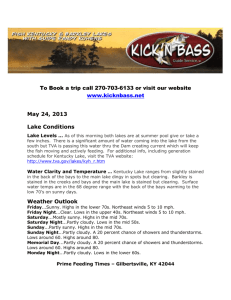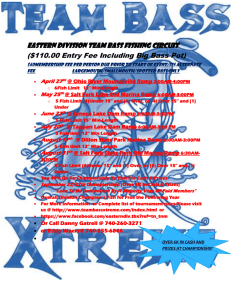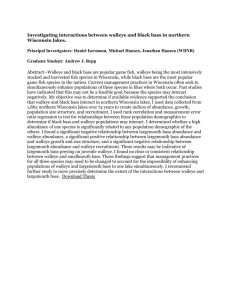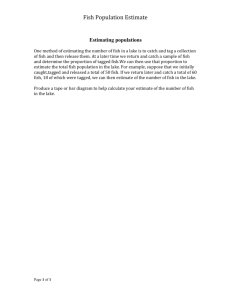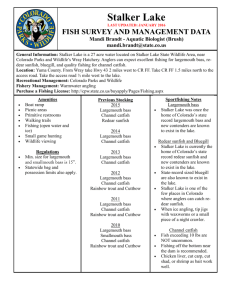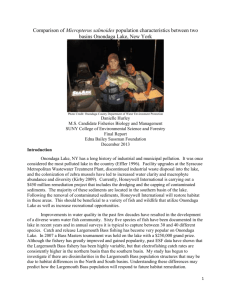Example Lake
advertisement
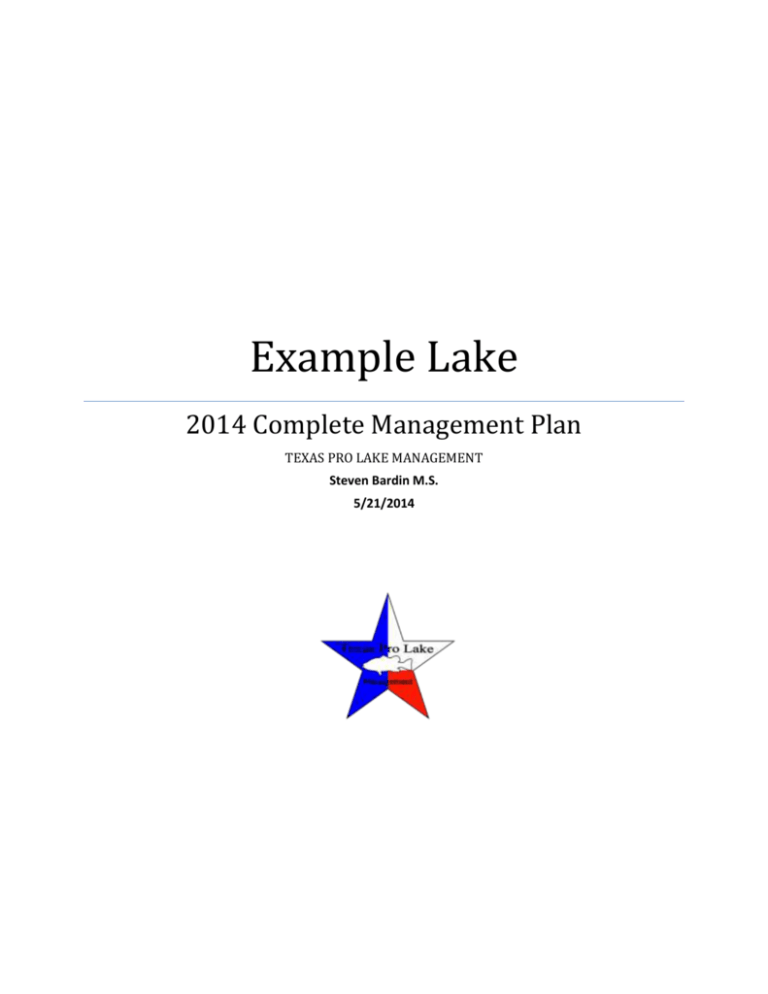
Example Lake 2014 Complete Management Plan TEXAS PRO LAKE MANAGEMENT Steven Bardin M.S. 5/21/2014 Texas Pro Lake Management Steven Bardin 972-824-3986 steven@texasprolakemanagement.com www.texasprolakemanagement.com Introduction: On May 1st, 2014 the 20 surface acre lake on Example Ranch called Large Lake was electrofished by Texas Pro Lake Management. The goal of the survey was to determine the condition of the current baitfish population and the status of predator fish. This winter cormorants and pelicans have both been observed feeding in the lake and there was some concern as to the impact they may have had on the fishery. At this time the goal of this fishery is to be a managed as a Trophy largemouth bass fishery. Description: Currently the lake water color is green with a visibility of 24 inches. Water temperature was 76°F. The lake was very low due to years of drought conditions. At this time the surface area of Large Lake is estimated to be 13.5 acres. Aquatic vegetation was not observed in the lake and is being controlled by water turbidity and triploid grass carp. Rock piles and contour changes were the main structures present at this time. Fishery Assessment: Electrofishing was conducted using a Smith-root 1.5 KVA electro fisher with a Honda 2000W generator. Conductivity was measured to be 330 µs in the lake. Electrofishing was conducted at 141 DCV at 7 amps. The duration of the electrofishing was 1 hour of continuous sampling. Species observed during the survey included coppernose bluegill sunfish, redear sunfish, channel catfish, triploid grass carp, silverside minnows and largemouth bass. Largemouth bass were counted, weighed to the nearest tenth of a lb. and measured to the nearest tenth of an inch. All bass caught under 16 inches in length were culled from the lake and taken by ranch staff. The measured weight was then compared to standard weight to determine relative weight (Wr= Measured W/ Standard W * 100). Relative weights of 90-110% are preferred in a trophy fishery. All other species were counted to determine relative abundance. Abundance of fish species and sizes will be categorized as highly abundant, abundant, present, less than abundant, and absent. 2 Texas Pro Lake Management Steven Bardin 972-824-3986 steven@texasprolakemanagement.com www.texasprolakemanagement.com Results Currently the forage fish population included coppernose bluegill sunfish and redear sunfish. Bluegill sunfish are an excellent forage fish which reproduce multiple times from April to October. The bluegill sunfish were found to be present at all sizes. Smaller bluegill 1-2 inch individuals were observed in small schools in shallow water only. Medium 3-5 inch bluegill were present but were not overly abundant. Large sized bluegills 5-7 inches in length were found to be abundant at this time. Redear sunfish are considered vital in all small water bodies. This is due to the fact that they feed mainly on snails which can carry parasites. Redear sunfish were found to be present at a large size from 5-9 inches only. This is acceptable and expected due to redear sunfish limited reproductive cycles. Silverside minnow were found during the survey in small schools. These minnows are a native fish and were not originally stocked into the lake. Instead these fish were probably in the lake from the original construction. Triploid grass carp were observed multiple times at a length of greater then 3ft and weight over 40 lbs. These fish are currently controlling all vegetation in the lake. During the survey a total of 68 largemouth bass were captured. These bass had lengths from 8.5-21 inches and weights from .35- 5.35 lbs. The average weight of largemouth bass at this time was found to be 1.75 lbs and the average length is 14.10 inches. Figures and Charts: Species Length 1-3 Inches Bluegill Sunfish 3-5 Inches “ 5-9 Inches “ 5-9 inches Redear Sunfish 16 Inches Channel Catfish Silverside Minnows 2-3 Inches 36+ Inches Grass Carp R/C Status # Captured Released Some 6 Released Present 18 Released Abundant 29 Released Present 6 Released Present 1 Released Present Dozens Present 5 Frequency of Largemouth Bass by Grouped Lengths Under 10 inch 10-12 inch 3 13-15 inch Over 16 inch Texas Pro Lake Management steven@texasprolakemanagement.com www.texasprolakemanagement.com Actual Weight Compared to Standard Weight of Largemouth Bass 6.00 Actual Weight 4.00 Standard Weight 2.00 21 19 18 18 17 16 16 15 15 14 14.5 14 14 13 13 12 12 11.5 11 11 10 10 0.00 8.5 Weight in Lbs. Steven Bardin 972-824-3986 Length in Inches Relative Weight % Relative Weight Wr of Largemouth Bass 125 100 Relative Weight Expon. (Relative Weight ) 75 12 14 16 18 20 Length in Inches Analysis: Large Lake has an extremely balanced bass population. There is an even distribution between small, medium, and large sized bass. This means there are bass fish moving up to replace the older declining fish. The young of last year grew to 8-9 inches but are in low abundance due to predation by larger bass. All bass were near or over standard weight and the relative rate average for the population is 100%. At this time the largemouth population could not be better. The density of largemouth bass is also excellent. Capturing 68 bass per hour is a fairly high number for electrofishing. The baitfish abundance was slightly lower than expected. The larger size bluegills were found to be abundant. However, all other sizes were in low abundance due mainly to cormorant predation. Threadfin shad were also absent at this time presumably because of the extremely cold winter this past year. To continue supporting the remarkable largemouth bass population in this lake some improvement to forage fish can be made. 4 Texas Pro Lake Management Steven Bardin 972-824-3986 steven@texasprolakemanagement.com www.texasprolakemanagement.com Recommendations: At this time the goal of this fishery remains to create a trophy largemouth bass lake. The following recommendations will first attempt to achieve this goal. 1) Continuing the culling of largemouth bass from the lake when caught inside the slot limit of 10-16 inches will help to maintain the excellent largemouth bass population. A minimum of 25 largemouth bass per acre should be the target number removed per year. By removing these bass forage should continue to increase in quality and quantity. At the same time the overall average size of largemouth bass will also increase greatly. 2) Based on the electrofishing assessment bluegill sunfish were captured in low numbers. To improve the bluegill numbers a total of 100 4-5 inch bluegill sunfish per surface acre is recommended. This size bluegill sunfish will be mature and begin reproducing quickly; it is also likely that this size bluegill will not be eaten by largemouth bass easily. This stocking can be done at any time and will complement the culling of largemouth bass to help increase bass growth and forage fish density. Cost of this stocking would be $1.25 per 4-5 inch bluegill sunfish plus a delivery fee depending on supplier. 3) Diversifying the food chain will help to relieve the forage pressure on small bluegill sunfish. At this time it is recommended to stock threadfin shad into the lake this spring/summer. Threadfin Shad are a preferred forage fish of largemouth bass. Threadfin grow to a maximum size of 6 inches. They feed directly on phytoplankton in open water. Threadfin begin to reproduce when water temperature reaches 70 degrees and will continue throughout the summer. The shad will lay their eggs in early morning in shallow water in large schools. They will build a large population fairly quickly. These fish are somewhat temperature intolerant and tend to die around 42 degrees. If winter waters temperatures do fall below 42 degrees it will be recommended to restock threadfin shad. Cost of this stocking would be $300 per 1000 plus delivery fee depending on supplier. 4) To improve survivability of the forage fish it is recommended to explore the addition of dense shoreline artificial structures. When placing these structures it is best to make 3-4 large dense areas of structure. The structures should be placed in 3-5 ft of 5 Texas Pro Lake Management Steven Bardin 972-824-3986 steven@texasprolakemanagement.com www.texasprolakemanagement.com water and are designed to increase survivability of forage fish only. The greater the surface area of a structure, the greater amount of fish that the structure can support. Not only does this provide a physical environment, it also creates a microenvironment within the lake. Maximized surface area promotes the growth of beneficial algaes which attract and feed macro invertebrates. Macro invertebrates are a fundamental food source for baitfish, as well as a possible indicator species for good water quality. These structures can be built at the ranch or purchased. Examples of these structure types can be found below. Homemade: Purchasable: Cradle by Fishiding Self weighted, Made of vinyl siding Cost $50 each 12 of these would be recommended to make 3 large structures 5) Providing supplemental fish food will quickly increase the growth rate of the bluegill sunfish. A fish feeder mounted on the bank would be the easiest way to provide this additional feed. The feeder would only run once a day and would feed approximately ½ lb of fish food per feeding. The feeder should feed daily from April to November. If no feeders are available new Texas Hunter Fish Feeder would 6 Texas Pro Lake Management Steven Bardin 972-824-3986 steven@texasprolakemanagement.com www.texasprolakemanagement.com be the feeder of choice. They are by far the best feeder on the market. This feeder will hold 50 lbs of feed. This feeder uses an air blower system and does not have food sitting directly on the throwing mechanism therefore reducing the amount of feed which could be lost to varmints. A Purina Aquamax fish food is the recommended feed to feed the bluegill. This feed is designed to grow bluegill to sizes over 1 lb. Making them a true game fish and unable to be eaten by the largemouth bass. Cost per feeder: $689.00 plus $79.00 for a solar panel and shipping and tax. Summary: Electrofishing survey completed 5/20/14 Largemouth bass were abundant at all sized and very close to standard weight. To maintain average largemouth bass size it is recommended to cull fish caught within 10-16 inches in length. Remove a minimum of 25 bass per acre per year. Bluegills were not observed in high density. To improve their densities plan a stocking of 100 4-5 inch bluegill per acre. To increase bluegill growth rate begin feeding Purina Aquamax fish food once daily. Explore the addition of strategically placed artificial along the shoreline to improve survivability of forage fish. Potentially stock threadfin shad to diversify the food chain and reduce pressure on juvenile bluegill. 7
